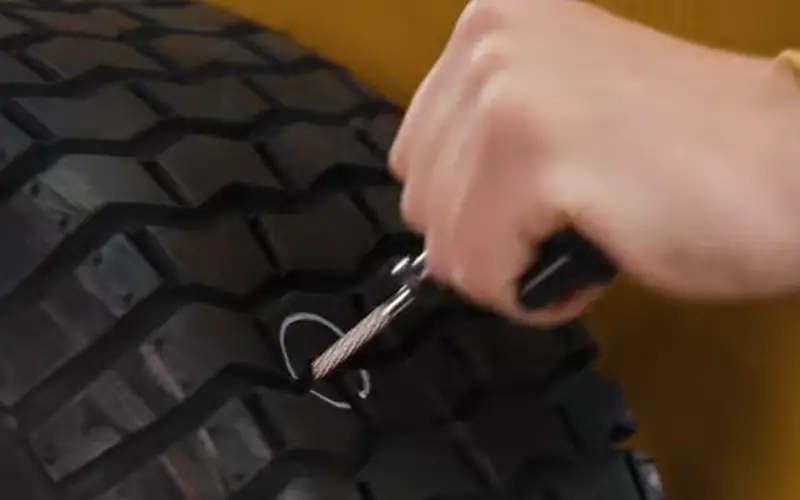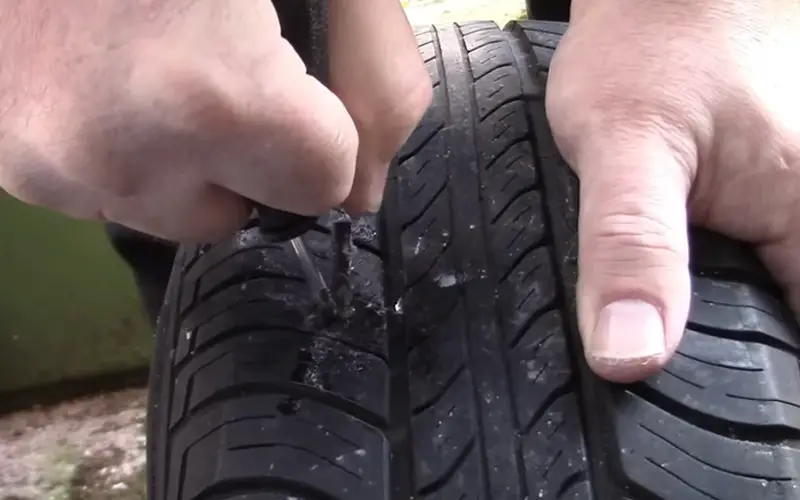Discount Tire is renowned for its stellar tire services, but does discount tire patch tires?
The answer is a resounding yes! Discount Tire does patch tires. If you have a flat or damaged tire, they offer tire patching services to fix punctures and ensure your tire is roadworthy. Simply bring your tire to Discount Tire, and their skilled technicians will assess and patch it, helping you get back on the road safely.
With a commitment to customer satisfaction, Discount Tire not only offers quality tires but also provides reliable and affordable solutions to keep you rolling smoothly. Say goodbye to tire troubles with Discount Tire’s expert patching services.
Can Discount Tire Patch a Tire?
Discount Tire can repair a tire by patching it. If you have a flat or damaged tire, they have the expertise to fix it using a patch, restoring its functionality. Simply bring your tire to a Discount Tire location, and their skilled technicians will assess the damage and determine if a patch is a suitable solution. They’ll efficiently patch up the tire, getting you back on the road safely and saving you the cost of a replacement.
Does Discount Tire Patch Tires for Free?
Discount Tire provides free tire patching. If you get a nail or encounter a small puncture, they’ll fix it at no cost. They’ll mend your tire efficiently and get you back on the road without any extra charges. It’s a convenient service they offer to keep your tires in good shape without breaking the bank.
Why Do You Need Tire Patching?
Tire patching is essential to fix punctures and maintain optimal tire performance. When your tire encounters a nail or sharp object, it can cause a slow leak, leading to reduced air pressure. Patching seals the puncture, preventing further damage and maintaining proper inflation. This ensures safer driving by preventing blowouts and enhancing fuel efficiency. Regular patching also extends tire lifespan, saving you money in the long run. It’s a cost-effective solution that keeps you on the road safely and avoids the hassle of unexpected breakdowns.
Types of Tire Patches

There are 5 types of tire patches commonly used for repairing punctures and leaks in tires. Here are some of the most common ones:
- Plug Patch: This is a combination repair where a plug (usually made of rubber) is inserted into the puncture from the inside of the tire, and then a patch (also made of rubber) is applied to cover the puncture from the outside. This type of patch provides a strong and durable repair.
- Patch Plug: Similar to the plug patch, the patch plug repair involves inserting a plug into the puncture from the inside of the tire, but instead of applying a separate patch from the outside, a patch with a built-in plug is used. This type of patch is also effective in providing a long-lasting repair.
- Chemical Patch: Also known as a patch and go, this type of repair involves using a chemical solution along with a patch to seal the puncture. The chemical solution helps bond the patch to the tire surface, creating a tight seal. Chemical patches are often used for temporary repairs or as a quick fix until a proper repair can be done.
- Self-Vulcanizing Patch: These patches are made of a rubber compound that becomes soft and sticky when heated. They are applied to the puncture area and then heated using a special tool or a heat gun. As the patch cools down, it vulcanizes (chemically bonds) with the tire surface, creating a strong and permanent repair.
- Tube Patch: Tube patches are specifically designed for repairing inner tubes in tires. They are made of rubber and have a strong adhesive backing that bonds to the inner tube surface. Tube patches are commonly used for repairing bicycle and motorcycle inner tubes.
How Much Does Discount Tire Charge to Patch a Tire?
The cost of getting a tire patch at Discount Tire can vary depending on factors such as the location, the type of tire, and the extent of damage. Generally, the cost for a basic tire patch at Discount Tire ranges from $10 to $30. However, if the damage is more extensive or if additional services are required, such as tire balancing or alignment, the cost can be higher. It’s always best to contact your local Discount Tire store for an accurate quote based on your specific situation.
How Does Discount Tire Patch Tires?

Taking care of your tires is crucial for a smooth and safe driving experience. When you encounter a pesky puncture, Discount Tire comes to the rescue with its tire patching service. The eight simple steps Discount Tire follows to patch tires effectively, ensure you get back on the road with confidence.
Step 1: Inspection
The first step in the tire patching process is a thorough inspection. A skilled technician at Discount Tire carefully examines the damaged tire to assess the extent of the puncture. This step is crucial to determine whether a patch is a viable solution or if a replacement is necessary. The technician looks for punctures, cuts, or any other damage that may compromise the tire’s integrity.
Step 2: Marking the Puncture
Once the technician identifies the location of the puncture, they mark it for precision. Using chalk or a similar tool, they highlight the exact spot where the tire needs patching. This step ensures that the patch is applied precisely to the damaged area, enhancing the effectiveness of the repair.
Step 3: Removing the Tire
With the puncture marked, the technician proceeds to remove the tire from the wheel. This step is crucial for a thorough inspection of both the inner and outer surfaces of the tire. The technician might obtain better access to the punctured area by carefully detaching the tire and preparing it for patching.
Step 4: Prepping the Puncture
Before applying the patch, the technician cleans and preps the punctured area. Using a specialized tool, they remove any debris, nails, or foreign objects lodged in the tire. Cleaning the puncture site ensures a secure and lasting bond between the tire and the patch. This meticulous preparation is a key factor in the success of the patching process.
Step 5: Applying the Patch
Now comes the heart of the tire patching process – applying the patch. The technician selects a high-quality patch that matches the size and type of the puncture. They use a strong adhesive to bond the patch securely to the tire. Care is taken to ensure that the patch completely covers and seals the puncture. This step is crucial for preventing air leaks and maintaining the tire’s structural integrity.
Step 6: Sealing the Patch
After applying the patch, the technician takes extra measures to ensure a watertight and airtight seal. This may involve using a sealant or additional adhesive around the edges of the patch. The goal is to fortify the patch’s bond, preventing any further damage or air leakage. This meticulous sealing process contributes to the longevity of the patched tire.
Step 7: Reinstalling the Tire
With the patch securely in place and the seal perfected, the technician reinstalls the tire onto the wheel. They carefully align the tire, making sure it sits snugly on the wheel rim. Proper alignment is essential for balanced and safe driving. The technician then tightens the lug nuts to the manufacturer’s specifications, ensuring the tire is securely fastened to the wheel.
Step 8: Quality Assurance
Before handing the repaired tire back to the customer, Discount Tire conducts a final quality assurance check. This involves inspecting the patched area, verifying the tire’s overall condition, and conducting a pressure test to ensure there are no air leaks. The tire is also balanced to guarantee a smooth ride. This thorough quality check ensures that the patched tire meets the highest safety and performance standards before it hits the road again.
Benefits of Patching Tires
Patching tires offers several benefits, contributing to safety, cost savings, and environmental impact. Here are some key advantages:
- Cost-Effective: Patching a tire is generally more cost-effective than replacing it entirely. Tire patches are affordable, and the process requires less labor compared to installing a new tire.
- Extended Tire Lifespan: Patching allows you to extend the life of a tire that might still have significant tread depth. This is especially beneficial for tires that are otherwise in good condition and have not reached the end of their usable life.
- Reduced Environmental Impact: Repairing a tire instead of disposing of it helps reduce environmental impact. Tires take a long time to decompose in landfills, and proper patching promotes a more sustainable approach to tire maintenance.
- Time Savings: Repairing a punctured tire is usually quicker than replacing it. This can be particularly important in situations where time is crucial, such as during a road trip or in emergencies.
- Maintains Vehicle Balance and Performance: A patched tire, when properly repaired, maintains the balance and performance of the vehicle. This ensures a smoother and safer driving experience.
- Safety: Patching a tire properly restores its structural integrity and prevents air leaks. This is crucial for maintaining optimal tire pressure, which is essential for vehicle control, handling, and fuel efficiency. Properly patched tires are less likely to experience blowouts, reducing the risk of accidents.
- Convenience: If a tire is punctured, especially in an inconvenient location, patching allows for a quick and convenient solution. This is particularly true for minor punctures that can be effectively repaired with a patch.
- Financial Savings: Patching a tire is usually more economical than purchasing a new one, making it a practical choice for individuals looking to save money on vehicle maintenance.
Will Discount Tire Plug a Tire for Free?
Discount Tire typically charges for tire plug services. They do not provide tire plug repairs for free. If you need a tire plugged, you’ll likely incur a fee for the service at Discount Tire. Keep in mind that pricing may vary, so it’s advisable to contact your local Discount Tire store for specific details on costs associated with tire plug repairs.
Why Does Discount Tire Fix Flats for Free?
Discount Tire fixes flats for free as part of their commitment to customer satisfaction. They do this to keep customers happy and coming back for future tire needs. Providing this service without charge builds trust and loyalty among customers, ensuring they return for other tire-related services. It’s a way for Discount Tire to demonstrate its dedication to customer care and to stand out in a competitive market. They hope that offering free flat repairs makes the tire maintenance procedure easier and more convenient for their clients, thereby improving their overall experience.
FAQ
Not all types of tire damage can be patched. Punctures in the tread area caused by small nails or screws are often repairable with a patch. However, extensive sidewall damage, large cuts, or punctures near the tire shoulder may require replacement, as they can compromise the tire’s structural integrity.
Patching a tire, yourself is generally recommended for minor punctures. It’s a cost-effective solution and can save you time. Ensure you have a tire repair kit with easy-to-follow instructions. If the damage is extensive or near the sidewall, seek professional help.
A tire patch usually lasts for a decent amount of time, often providing a reliable fix for punctures. The durability depends on the patch’s quality and the size of the puncture. In general, a well-applied patch can keep your tire in good shape for several thousand miles before needing further attention.
Most tire shops provide patching services. Nearly all places that sell tires can fix small punctures by patching the damaged area. It’s a common and convenient service offered to extend the life of your tire, saving you the cost of a replacement.
